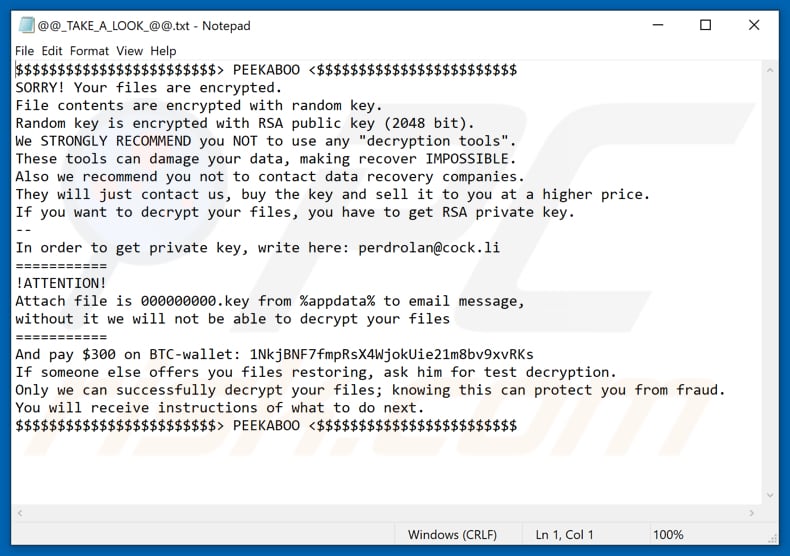What is Peekaboo ransomware? And how does it implement its attack?
Peekaboo ransomware is a file-encoding virus that appends the “.peekaboo” extension to the file it encrypts. This crypto-malware is designed to lock important data in a computer, leaving them inaccessible to victims. It behaves like a typical ransomware threat which means that it follows the same sequence in its attack as with other crypto-malware. It starts to implement its attack through a malicious payload.

The moment its payload is dropped in the system, it creates new malicious files that are needed for the next phase of the attack. Some of these malicious files take control of essential system processes so that Peekaboo ransomware can remain undetected until it has finished its attack. Moreover, it also exploits the auto-execute system functionality by setting some malicious values in the Run and RunOnce registry sub-keys.
Once this happens, it achieves persistence on the infected device. After the alterations are made, Peekaboo ransomware scans the system to look for files to encrypt. Typical ransomware threats like this one usually target user-generated files like documents, videos, images, audio, and many more. Once it finds these files, it encrypts them using the DES encryption algorithm and adds the .Peekaboo extension to each one of the encrypted files. It then drops a text file named “@@_TAKE_A_LOOK_@@.txt” which contains the following message:
“$$$$$$$$$$$$$$$$$$$$$$$$> PEEKABOO <$$$$$$$$$$$$$$$$$$$$$$$$ SORRY! Your files are encrypted. File contents are encrypted with random key. Random key is encrypted with RSA public key (2048 bit). We STRONGLY RECOMMEND you NOT to use any “decryption tools”. These tools can damage your data, making recover IMPOSSIBLE. Also we recommend you not to contact data recovery companies. They will just contact us, buy the key and sell it to you at a higher price. If you want to decrypt your files, you have to get RSA private key. — In order to get private key, write here: [email protected] =========== !ATTENTION! Attach file is 000000000.key from %appdata% to email message, without it we will not be able to decrypt your files =========== And pay $300 on BTC-wallet: 1NkjBNF7fmpRsX4WjokUie21m8bv9xvRKs If someone else offers you files restoring, ask him for test decryption. Only we can successfully decrypt your files; knowing this can protect you from fraud. You will receive instructions of what to do next. $$$$$$$$$$$$$$$$$$$$$$$$> PEEKABOO <$$$$$$$$$$$$$$$$$$$$$$$$”
How does Peekaboo ransomware spread online?
Peekaboo ransomware uses the most common distribution method for ransomware infections – malicious spam email campaigns. Developers of Peekaboo attach a corrupted file in emails containing some commands used to launch the ransomware threat into the targeted system. The corrupted file may be a document, a PDF file, an executable file, or a link to a malicious website.
Follow the removal instructions provided below in eliminating Peekaboo ransomware from your computer and recovering encrypted files.
Step_1: Close the ransom note of Peekaboo ransomware and end its malicious processes via Task Manager. To open it, tap Ctrl + Shift + Esc keys on your keyboard.
Step_2: Under the Task Manager, go to the Processes tab and look for any suspicious-looking process that takes up most of your CPU’s resources and is most likely related to Peekaboo ransomware.
Step_3: After that, close the Task Manager.
Step_4: Tap Win + R, type in appwiz.cpl and click OK or tap Enter to open Programs and Features under Control Panel.
Step_5: Under the list of installed programs, look for Peekaboo ransomware or anything similar, and then uninstall it.
Step_6: Next, close the Control Panel and tap Win + E keys to launch File Explorer.
Step_7: Navigate to the following locations below and look for the malicious components of Peekaboo ransomware such as @@_TAKE_A_LOOK_@@.txt and [random].exe as well as other suspicious files, then delete all of them.
- %TEMP%
- %WINDIR%\System32\Tasks
- %APPDATA%\Microsoft\Windows\Templates\
- %USERPROFILE%\Downloads
- %USERPROFILE%\Desktop
Step_8: Close the File Explorer.
Before you proceed to the next steps below, make sure that you are tech-savvy enough to the point where you know exactly how to use and navigate your computer’s Registry. Keep in mind that any changes you make will highly impact your computer. To save you trouble and time, you can just use [product-name], this system tool is proven to be safe and excellent enough that hackers won’t be able to hack into it. But if you can manage Windows Registry well, then by all means go on to the next steps.
Step_9: Tap Win + R to open Run and then type in Regedit in the field and tap enter to pull up Windows Registry.
Step_10: Navigate to the following path:
- HKEY_CURRENT_USER\Control Panel\Desktop\
- HKEY_USERS\.DEFAULT\Control Panel\Desktop\
- HKEY_LOCAL_MACHINE\Software\Microsoft\Windows\CurrentVersion\Run
- HKEY_CURRENT_USER\Software\Microsoft\Windows\CurrentVersion\Run
- HKEY_LOCAL_MACHINE\Software\Microsoft\Windows\CurrentVersion\RunOnce
- HKEY_CURRENT_USER\Software\Microsoft\Windows\CurrentVersion\RunOnce
Step_11: Delete the registry keys and sub-keys created by Peekaboo ransomware.
Step_12: Close the Registry Editor and empty the Recycle Bin.
Try to recover your encrypted files using the Shadow Volume copies
Restoring your encrypted files using Windows Previous Versions feature will only be effective if Peekaboo ransomware hasn’t deleted the shadow copies of your files. But still, this is one of the best and free methods there is, so it’s definitely worth a shot.
To restore the encrypted file, right-click on it and select Properties, a new window will pop up, then proceed to Previous Versions. It will load the
file’s previous version before it was modified. After it loads, select any of the previous versions displayed on the list like the one in the illustration below. And then click the Restore button.
Congratulations, you have just removed Peekaboo Ransomware in Windows 10 all by yourself. If you would like to read more helpful articles and tips about various software and hardware visit fixmypcfree.com daily.
Now that’s how you remove Peekaboo Ransomware in Windows 10 on a computer. On the other hand, if your computer is going through some system-related issues that have to get fixed, there is a one-click solution known as Restoro you could check out to resolve them.
This program is a useful tool that could repair corrupted registries and optimize your PC’s overall performance. Aside from that, it also cleans out your computer for any junk or corrupted files that help you eliminate any unwanted files from your system. This is basically a solution that’s within your grasp with just a click. It’s easy to use as it is user-friendly. For a complete set of instructions in downloading and using it, refer to the steps below
Perform a full system scan using Restoro. To do so, follow the instructions below.












